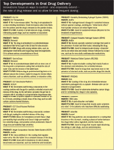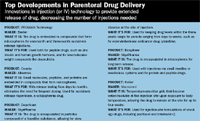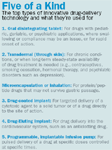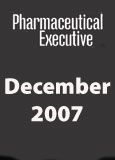Special Delivery: A Guide to the New Technologies
Getting innovative drugs into bodies just got a whole lot more interesting. Here's how the delivery biz is keeping up with pharma's R&D.
Adopting new drug-delivery technologies requires a well-defined strategy in order to mitigate the risk of product failure. Such a plan must facilitate go/no-go decisions and adaptation during development. Ultimately, of course, to be successful, a product must clear many hurdles, including efficacy and safety, acceptance by patients and doctors, the ability to secure reimbursement, and manufacturing feasibility. Recent industry examples have magnified how critical such a strategy is. When done well, innovation in drug delivery can reap rewards and benefits on many levels. Many patents on products in use today are about to expire. Add to that both the greater use of biologics—with their large molecules that preclude traditional oral delivery—and the trend toward personalized medicince requiring highly targeted therapeutics, and it's clear why there is a growing need for delivery mechanisms that can do more than simply deposit small molecules into the bloodstream for distribution.
US sales of advanced drug-delivery systems were more than $54.2 billion in 2004. In 2005, they reached $64.1 billion, and they grew to $74.4 billion by the end of 2006. Over the next five years, the market is expected to grow at an average annual rate of 15.6 percent to reach $153.5 billion by 2011, according to an October 2006 BCC Research report.
The lead driver of this growth is demand: Some 40 percent of new chemical entities are rejected because of poor biopharmaceutical properties, according to the Food and Drug Administration. In some cases, these obstacles can be overcome by use of novel drug-delivery systems or devices. For example, a small biotech developing a recombinant protein drug, such as insulin or erythropoietin, may know that its product cannot be given orally because it breaks down too quickly in the upper GI tract or because the molecule's pH prevents it from being absorbed by the lower GI tract.
Rather than investing research dollars in trying to develop an enteric oral formulation that may still produce variable bioavailability, it may be more prudent to invest in buccal (through the cheek), sublingual (under the tongue), or inhalation routes for better absorption and efficacy. Certain therapeutic agents, such as stem cells or gene therapy, frequently require the use of delivery devices to target the agent to a particular organ.

Top Developments in Oral Drug Delivery
Larger pharmaceutical companies also depend on innovative drug-delivery systems. For example, when a drug is facing patent expiration and challenges by generic competitors, reformulating it with a new mode of delivery may enhance consumer appeal and provide more rapid onset of action as well as better outcomes. These improvements can translate into greater sales without the overwhelming costs of bringing a new drug molecule to market.

Top Developments in Parenteral Drug Delivery
In fact, advances are being made in many areas of drug administration (see "Five of a Kind"). Oral delivery mechanisms are benefiting from progress in microencapsulation technologies for controlled, delayed, and extended release of drugs. For parenteral (via injection or IV) administration, there is a focus on developing extended release or depot forms of drugs, so a biweekly or monthly subcutaneous or intramuscular injection can provide a steady release of drug. Such administration allows for better therapeutic control and patient compliance. (For more on specific innovations in oral and parenteral drug-delivery technology.)

Top Developments in Transdermal Drug Delivery
If the drug is a protein or peptide product, or a small molecule likely broken down by stomach acids, and injections are not a preferred method of administration, a non-oral drug-delivery system, such as buccal, transdermal (through a skin patch), or inhalation may be viable. The high rate of buccal absorption of many drug molecules also allows for better bioavailability because of the lack of the effects of food and gastric acid in the GI tract.

Five of a Kind
Innovations in medical device technology are also benefiting drug-delivery device technology. The advantages of using devices like implantable pumps include the ability to deliver a defined dose at defined intervals, or continuously to a defined anatomical area, or systemically. In other cases, such as gene therapy, a delivery catheter is an essential component to assure that the appropriate quantity of material is delivered to the precise location where it is needed.
Innovation in drug-delivery technology is a dynamic process. With the changing face of therapeutic options today, the advent of nanotechnology, and the trend toward more biopharmaceuticals and personalized medicine, delivery innovation is likely to accelerate. For today's pharmaceutical-formulation scientists, there are certainly a number of tricks to pull out of the drug-delivery-technology hat. The Czech novelist Milan Kundera stated, "Business has only two functions—marketing and innovation." In the current climate of pharma, it is critical that the industry embrace new delivery innovations to remain competitive.
Barry Sall is principal consultant and Irach Taraporewala is senior consultant at Parexel Consulting. They can be reached at barry.sall@parexel.com and irach.taraporewala@parexel.com respectively.

FDA Grants Priority Review to Regeneron’s Eylea for Macular Edema Following Retinal Vein Occlusion
April 18th 2025Regulatory action was based on data from the Phase III QUASAR trial, which demonstrated that Eylea HD dosed every eight weeks achieved non-inferior visual acuity outcomes compared to Eylea in patients with macular edema following retinal vein occlusion.
Addressing Disparities in Psoriasis Trials: Takeda's Strategies for Inclusivity in Clinical Research
April 14th 2025LaShell Robinson, Head of Global Feasibility and Trial Equity at Takeda, speaks about the company's strategies to engage patients in underrepresented populations in its phase III psoriasis trials.
New Insights Into T Cell Exhaustion and Inflammation in Long COVID
April 17th 2025Nigel McCracken, chief operating officer, Virax Biolabs, discusses new findings that reveal altered cytokine activity and evidence of T cell exhaustion in long COVID patients, providing deeper insight into post-infection immune disruption.
Key Findings of the NIAGARA and HIMALAYA Trials
November 8th 2024In this episode of the Pharmaceutical Executive podcast, Shubh Goel, head of immuno-oncology, gastrointestinal tumors, US oncology business unit, AstraZeneca, discusses the findings of the NIAGARA trial in bladder cancer and the significance of the five-year overall survival data from the HIMALAYA trial, particularly the long-term efficacy of the STRIDE regimen for unresectable liver cancer.
Amgen’s Imdelltra Demonstrates Significant Overall Survival Improvement in Small Cell Lung Cancer
April 16th 2025In the Phase III DeLLphi-304 trial, patients with small cell lung cancer administered Imdelltra achieved a statistically significant and clinically meaningful improvement in overall survival compared to standard-of-care chemotherapy.